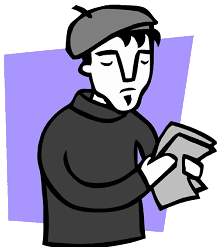Stressed And Unstressed Syllables Poetry
Rhythm in Poesy – You Tin Browse, Human being

Every bit I explained in Rhythm in Poetry – The Basics , some syllables in English language are " stressed " – pronounced louder or with more accent than others – while other syllables are "unstressed," meaning they are not emphasized. Knowing this, yous tin create patterns of stressed and unstressed syllables in your writing to create a rhythm in the words. Having rhythms in your poems make them more fun to recite and easier to remember.
To make it easy to spot the stressed and unstressed syllables in the examples I gave, I wrote them in UPPERCASE and lowercase letters, like this:
my PUPpy PUNCHED me IN the EYE.
The trouble with using this method is that it is awkward to write or type this way, and it makes the verse form more than hard to read. Likewise, if you accept a poem that is already printed on paper, yous wouldn't desire to have torewrite the entire matter simply to evidence the rhythm.
Wouldn't it be better if could make marks to show the stressed and unstressed syllables? Indeed, in that location is such a organisation that is commonly used, and it's called "scansion" (pronounced "scan-shun"). The process of marking the stressed and unstressed syllables in a poem is chosen "scanning."
Scanning Poetry
The most common method of scanning a verse form is to place marksabove the syllables to indicate whether they are stressed or unstressed. The mark for a stressed syllable is a slash ("/") and the mark for an unstressed syllable is a dash ("-"). Using these ii simple symbols, we can marker lines of poesy to see their rhythms, similar this:
- / - / - / - / My puppy punched me in the center.
At present, just by looking at the dashes and slashes, you can easily encounter that this line of poetry has a repeating rhythm. The first syllable is unstressed, the second is stressed, the third is unstressed, then on. In other words, the line alternates between stressed and unstressed syllables.
Counting Your Anxiety
In Rhythm in Poetry – The Nuts , I also explained how poets typically count "feet" rather than syllables. A " foot " is a grouping of syllables that create the rhythm of the verse form.
Most poetic anxiety contain a unmarried stressed syllable, and 1 or two unstressed syllables. So you tin usually count the number of feet in a line of poetry just by counting the dashes subsequently you scan it.
Knowing this, we can meet that the line "My puppy punched me in the eye" contains four feet, and each foot is two syllables long. Let'southward take a expect at another instance.
- / - - / - I didn't go camping.
I promise you can meet that this line has2 feet (because at that place are two stressed syllables in the entire line), and each foot has three syllables (unstressed – stressed – unstressed). The commencement human foot is "I didn't" and the second foot is "become camping ground." If we were to scan the unabridgedstanza (a "stanza" is what nosotros telephone call a paragraph or poetry of a verse form), information technology would look like this:
- / - - / - I didn't become camping. - / - - / - I didn't get hiking. - / - - / - I didn't go fishing. - / - - / - I didn't go biking.
Find that each of the four lines in this stanza have the exact same rhythm. That is, they have the same number of feet, and the same placement of stressed and unstressed syllables.
At present it's your plough to try your hand at scanning. Print out this page and use a pen or pencil write the scansion marks nearly each line in this stanza:
My female parent said to exercise my chores,to dust the shelves and mop the floors,and wipe the walls and wind the clocks,and scoop the kitty'due south litter box.
When y'all are done scanning this stanza, hither are a few questions to answer:
- How many anxiety are in each line?
- How many syllables are in each human foot?
- Do all four lines have the aforementioned rhythm?
Hold your mouse over this line to see if you got the right answers.
Why Scan?
So, why would you want to larn how to scan poems? There are a number of ways in which scanning poems can exist helpful when you are learning to write verse.
- You lot tin browse poems written by others to see what kinds of rhythms they use.
- You can scan your own poems to encounter if in that location are whatsoever mistakes in your rhythms (missing or extra syllables, misplaced stresses, etc.)
- Knowing how to scan poems tin help you to experiment with different kinds of rhythms in your poems.
Now you know the nuts of scansion. If y'all would like a petty more exercise, feel complimentary to print out whatever of the poems on poetry4kids.com and add together browse marks to them with a pen or pencil.
In the next Rhythm in Poetry lessons, I volition innovate the unlike kinds of anxiety you will find in poems and prove you how to use them in your own poems. Until then, happy scanning!
Next lesson: I Am the Iamb
Stressed And Unstressed Syllables Poetry,
Source: https://poetry4kids.com/news/rhythm-in-poetry-you-can-scan-man/
Posted by: rileywithery.blogspot.com


0 Response to "Stressed And Unstressed Syllables Poetry"
Post a Comment